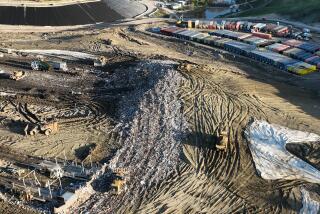Too Big a Stink Over Waste Plant
Deciding where to put essential but unpopular facilities such as cellular phone antennas or sewage treatment plants are among the toughest decisions faced by local government. And often they degenerate into tough fights. Case in point: The three-year battle to open a septic waste dumping site in the Sepulveda Basin. Los Angeles public works officials finished the $2-million facility in 1993 but never opened it because environmentalists pointed out that the city failed to first conduct an environmental review--a mistake that added another $500,000 to the price tag.
Last month the Board of Public Works recommended opening the facility to accept waste from portable toilets, septic tanks and cesspools. At the moment, waste is dumped into seven maintenance holes, most of which are under public streets. But neighbors and environmentalists never want the dump site to open, claiming that it will spoil recreational opportunities in the basin, which include trails as well as golf courses and open space.
Opponents were instrumental in forcing the city to rectify its inexcusable lack of review. But now that the appropriate studies are complete, the City Council should follow the recommendation of the public works board and open the facility. Doing so allows the city to charge waste haulers a per-gallon fee rather than the current flat rate. It is also potentially safer than current dumping sites, which are near residential neighborhoods. Besides, the facility is already finished and ready to go. The city is not so flush with cash that it can afford to build facilities it never opens.
The argument that the facility will ruin the Sepulveda Basin park falls apart when one considers that it is built on a former sod farm right next to the largest sewage treatment plant in the San Fernando Valley, the Donald C. Tillman Water Reclamation Plant. To minimize the effect on other parts of the park, however, the council should limit the hours of operation and extend Haskell Avenue south of Victory Boulevard to give trucks easier access. No one wants these kinds of public facilities in their backyard, but they have to go somewhere. With the proper restrictions, the facility in the basin makes sense.
More to Read
Sign up for Essential California
The most important California stories and recommendations in your inbox every morning.
You may occasionally receive promotional content from the Los Angeles Times.










